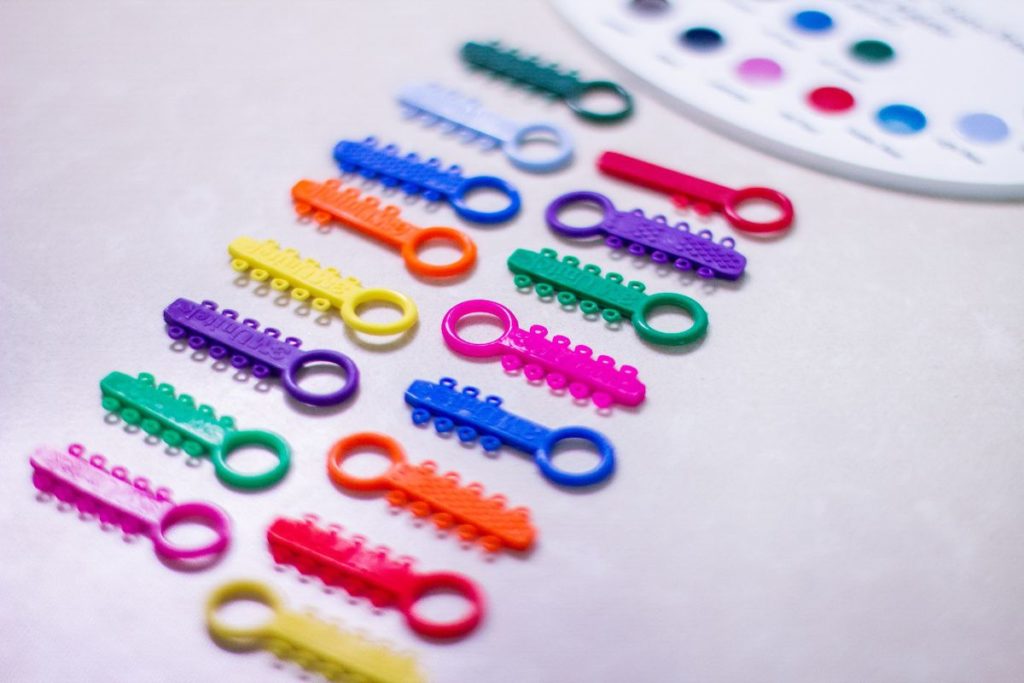Starting orthodontic treatment with braces can come with its fair share of challenges. From food restrictions and adjustment appointments to broken brackets and bent wires, braces take some getting used to! You may see rubber bands as yet another hurdle to overcome, but like everything else associated with braces treatment, they’re an important (and temporary) part of the process.
Most patients in our Jackson and Brandon offices need to wear rubber bands at some point during treatment. These bands help to correct your bite alignment, reduce overbites or underbites, and can even open or close spaces. When you wear them as directed by Dr. Sandifer, they will help move your teeth into straighter positions, giving you an attractive, fully functioning smile and improving your oral health.
We know that all of the steps for braces care can add up, but they’re worth the result! We want you to feel confident in your treatment plan, so understanding why can make the process less frustrating if you have to wear rubber bands with your braces.
Whether you’re set to wear elastics full-time or part-time, we want you to be informed about why we use rubber bands with braces, how they work, and how they’ll benefit your smile. Take a look below to learn more!
The role of rubber bands in orthodontics
When it comes to aligning the teeth and jaws, traditional braces are one of our most effective tools. After we attach the brackets to your teeth, they’ll work with a set of wires that span from tooth to tooth to facilitate movement.
Although this can successfully align the upper and lower sets of teeth separately, there must be something connecting the arches to correct the bite fully. There are several ways to accomplish this, including more intense methods like headgear, functional appliances, and springs, but the most common method is rubber bands.
Rubber bands, or elastics, are the preferred method for several reasons. They’re far more subtle than bulky headgear, and tooth-colored elastics can blend in very well with your natural smile. You can also choose fun colors to showcase your personality or a little school spirit!
You’ll need to change your brand throughout the day, so they’re easy to put in and remove. They are stretchy and flexible, giving you a full range of motion when engaging in everyday activities like talking, yawning, eating, and brushing your teeth. Elastics are also versatile, cost-effective, and can correct almost all bite problems, including overbites, underbites, open bites, and crossbites.

Types of elastics
Oties are the smaller type of elastics and fit around the brackets to help the archwire retain its position. Dr. Sandifer uses the Damon System, so these are not required, but we still have many patients who love for us to tie on these colors for looks!
The larger elastics are known as rubber bands. These can be placed in several different configurations to match the tensile force requirements of your mouth. The most common is the top-to-bottom and inter-arch configurations. Rubber bands also apply pressure to your jaw, helping it achieve the proper alignment for your bite. Sandifer Orthodontics offers both types of elastics in various colors.
How orthodontic rubber bands work
While the brackets and archwires are busy moving your teeth along the gumline, rubber bands will help pull the jaw backward or forwards so that the bottom and top rows of teeth can line up correctly.
We start this process by placing a bracket with a hook along the right and left sides of your bottom and top teeth. We then attach rubber bands to these hooks on each side of the mouth. The amount of tensile force required to correct your specific orthodontic issues will determine the angle of your bands. This will improve your smile by helping your teeth fit together more comfortably. Dr. Sandifer even utilizes hooks on some of your wires later in treatment to get your bite to fit together or “seat” well.
Rubber bands can play an important role in speeding up the orthodontic process as long as you follow the instructions from Dr. Sandifer.
Using rubber bands correctly
It’s important that you follow our instructions carefully when wearing rubber bands. Doing so will ensure your treatment proceeds according to schedule and give you the best results in the quickest time possible.
For maximum effectiveness, Dr. Sandifer will likely advise you to wear your rubber bands 24/7. This means you will only take them out to brush, floss, put new bands in, and sometimes to eat. As with everything else in orthodontics, this will depend on your case. We generally don’t recommend taking the bands off while you sleep, and you should NEVER double up on bands, either. Many patients mistakenly believe it will speed treatment up, but it slows things down and can even cause damage to the roots.
Only use the rubber bands given to you by Dr. Sandifer. NEVER order these online or use your friend’s rubber bands. They come in all different forces and sizes which could damage your teeth and negatively affect your bite if you were to use one too strong with too small of a wire.
You may notice slight soreness in your mouth, teeth, and jaws during the first few days of wearing rubber bands. This is entirely normal and is only temporary. Don’t let this discourage you from keeping them in as directed! Wearing your elastics incorrectly can make your teeth more resistant to successful movement and slow down your treatment progress.
Every time you take a band out, you should discard it and put on a new one. Depending on your specific case, your daily activities, and the strength of the elastics you use, you may find yourself replacing bands multiple times each day, so be sure you always have an extra pack of bands handy.

Sandifer Orthodontics keeps your treatment on track
As you can see, wearing rubber bands with your braces is essential to your orthodontic treatment. They play a crucial role in moving your jaw and teeth into the correct alignment, which is what will give you that beautiful, straight smile you’re working for! Dr. Sandifer and the rest of our talented team are committed to making the orthodontic process as easy as possible for you.
If you’re interested in orthodontic treatment and want to learn more about how to get started, our team is here to help. Contact our office in Jackson or Brandon to schedule your free consultation and take the first step to your new smile.
